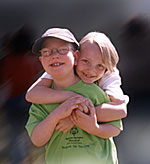Principal investigator: Bruce Simons-Morton, Ed.D., M.P.H.
This series of observational studies are designed to improve understanding of the nature of teen driving risk.
The 40-Teen Naturalistic Study
The purpose of this study is to evaluate the effects of experience on teen driving performance under various driving conditions. Researchers recruited 40 novice teen drivers at the time of licensure and equipped the teens’ vehicles with cameras, g-force meters, Global Positioning System (GPS), and other equipment to provide detailed information about driving performance during the first 18 months of driving experience. Of particular interest is driving performance in the presence or absence of teen passengers and at night versus during the day. Twenty of these teens share a vehicle with a parent, and these parents have agreed to be in the study to provide a comparison group.
Effect of Experience on the Driver Performance of Novice Teen Drivers
The purpose of this study is to assess the effect of driving experience on driving performance on a test track. The study uses standard measures of driving performance under controlled experimental conditions on a 1.2- mile test-track using a vehicle specifically designed for this purpose. The study aims to test the driving performance of a sample of teens within a few weeks of licensure, while they are still relatively inexperienced drivers, and then again after they have gained experience. Teen driving performance is compared with the performance of experienced adult drivers on the same measures.
Use of In-Vehicle Monitoring Devices
The purpose of this study is to determine the family interest in using electronic monitoring devices to supervise driving and how families use these devices. Researchers are interviewing a sample of families at Motor Vehicle Administration (MVA) offices to determine interest in electronic monitoring device use. Those who agree to use a device have their vehicles equipped with the instrumentation. The device records data when g-force limits are exceeded. Families are randomized to five different conditions: g-force counter only; event recording without feedback; event recording with immediate feedback in the form of a warning light; event recording and feedback that families need to download and analyze; event recording with facilitated feedback.
Teen Passenger Observation Study
The objective of this study is to observe and record driving performance of teenage drivers with and without passengers. The study examines the influence of passenger presence and passenger sex and age (i.e., child, teen, or adult) on driving performance. It compares risky driving performance (e.g., speed and following distance) of teenage drivers with that of mature drivers. Information about vehicles exiting high- school parking lots is recorded so the vehicles can be identified and their speed and following distance compared with that of usual traffic on a nearby road.
Supervised Practice Driving Study
This study seeks to: examine the nature of parent-supervised practice driving, and determine the extent to which the amount of practice is associated with driving performance after licensure. A sample of 100 families was recruited and will be observed and surveyed during a period of 18 months
DESPR Collaborators
· Marie Claude Ouimet, Ph.D.
· Jing Wang Ph.D.
Selected Publications
Lee SE, Klauer SG, Olsen ECB, Simons-Morton BG, Dingus TA, Ramsey DJ, & Ouimet, MC. (In press). Detection of road hazards by novice teen and experienced adult drivers. Transportation Research Board Record.
Olsen ECB, Lee SE, & Simons-Morton BG. (2008). Eye movement patterns for novice teen drivers: does 6 months of driving experience make a difference? Transportation Board Research Record, No. 2009, 8-14.
Ouimet MC, Williams AF, Simons-Morton BG, Leaf WA, Preusser DF, Hartos JL, & Noelcke E. (2008). Perceived risk and other predictors and correlates of teenagers’ safety belt use during the first year of licensure. Traffic Injury Prevention, 9(1):1-10. [Abstract]
Simons-Morton BG, Catalano R, & Ouimet MC. (In press). Driving inexperience as a cause and parent management as a solution to the novice young driver problem. American Journal of Preventive Medicine.
Simons-Morton BG. Parent involvement in novice teen driving: Rationale, evidence of effects, and potential for enhancing graduated driver licensing effectiveness. (2007). Journal of Safety Research, 38:193-202. [Abstract]
Lee, SE, Olsen ECB, & Simons-Morton BG. Eyeglance behavior of novice teen and experienced adult drivers. (2007). Transportation Research Board Journal, 1980:57-64.
Simons-Morton BG, Hartos J, Leaf W, & Preusser D. (2006). Do recommended driving limits affect teen-reported tickets and crashes during the first year of teen independent driving? Traffic Injury Prevention, 7:1-10. [Abstract]
Simons-Morton BG & Ouimet MC. (2006). Parent involvement and novice teen driving: A review of the literature. Injury Prevention, 12(Suppl 1):i30-i37. [Abstract]
Simons-Morton BG & Winston FK. (2006). Translational research in child and adolescent transportation safety. Evaluation and the Health Professions, 29(1):33-64. [Abstract]
Williams A, Leaf WA, Simons-Morton BG, & Hartos JL. (2006). Parents' views of teen driving risks, the role of parents, and how they plan to manage the risks. Journal of Safety Research, 7:23-30. [Abstract]
Williams A, Simons-Morton BG, Hartos JL, Leaf WA, & Preusser D. (2006). Vehicles driven by teenagers in their first year of licensure. Traffic Injury Prevention, 7:23-30. [Abstract]
Simons-Morton BG, Lerner N, & Singer J. (2005). The observed effects of teenage passengers on the risky driving behavior of teenage drivers. Accident Analysis and Prevention, 37(6):973-982. [Abstract]
Beck KH, Hartos JL, & Simons-Morton, BG. (2005). Parent-teen disagreement of parent-imposed restrictions on teen driving after one month of licensure: Is discordance related to risky teen driving? Prevention Science, 6(3):177-185. [Abstract]
Hartos JL, Simons-Morton BG, Beck KH, & Leaf WA. (2005). Parent-imposed limits on high-risk adolescent driving: Are they stricter with graduated driver licensing? Accident Analysis and Prevention, 37(3):557-562. [Abstract]
Simons-Morton BG, Mickalide A, & Olsen E. (2005). Preventing motor vehicle crash injuries among children and adolescents. In Liller K, (Ed.), Injury Prevention for Children and Adolescents: Integration of Research, Practice, and Advocacy. Washington DC: American Public Health Association.
